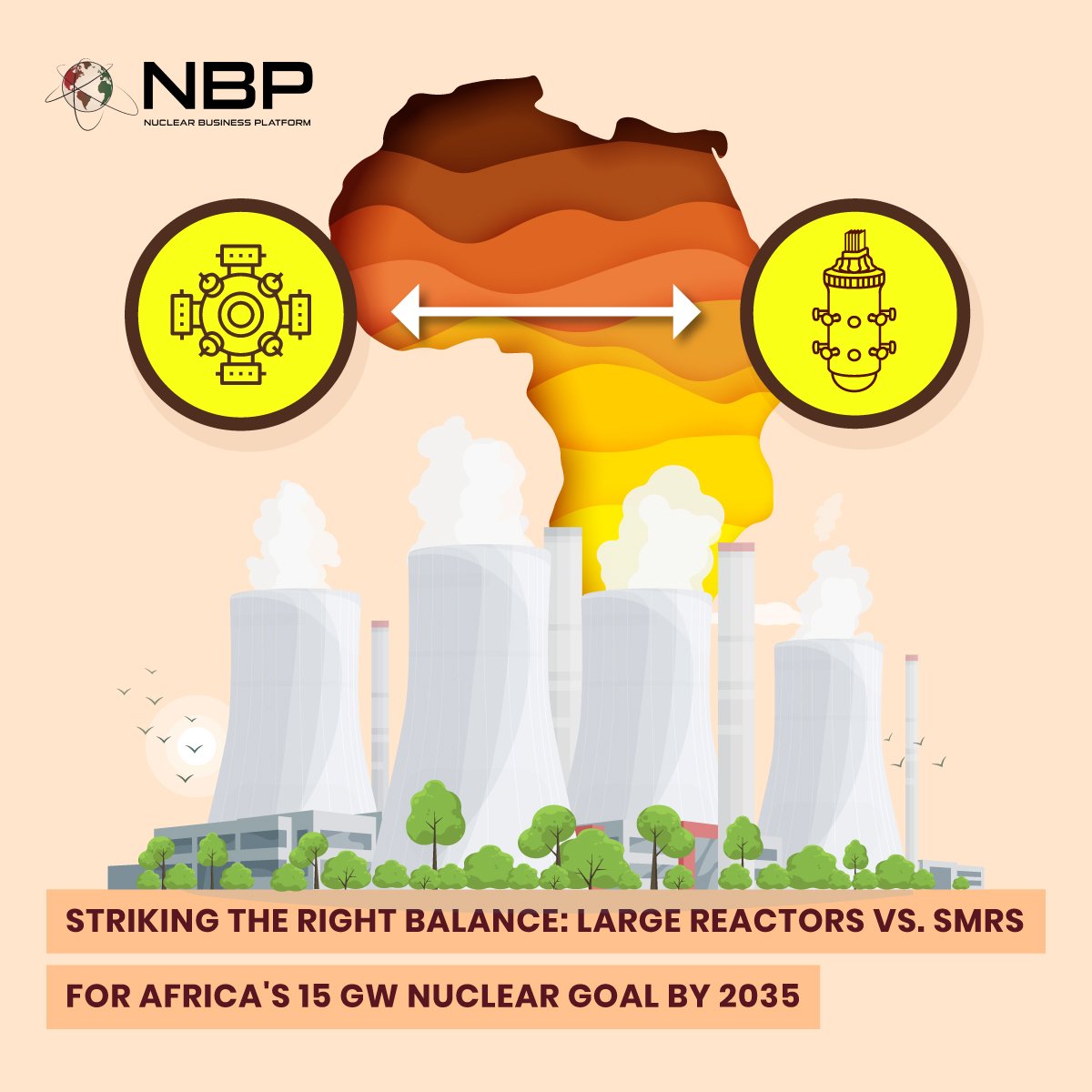Striking the Right Balance: Large Reactors vs. SMRs for Africa's 15 GW Nuclear Goal by 2035
Africa faces a monumental challenge: a rapidly growing population and burgeoning urbanization are driving a surge in energy demand. Currently, the continent houses 80% of the world's population lacking access to electricity, concentrated in Sub-Saharan Africa according to the International Energy Agency. Projections estimate a threefold increase in energy requirements by 2040. To address this looming crisis, nuclear energy is emerging as a compelling solution for fulfilling Africa's escalating energy needs in a sustainable and reliable manner. They are actively exploring both large-scale nuclear reactors and Small Modular Reactors (SMRs) as part of their strategies to address energy challenges.
The Nuclear Business Platform (NBP), a leading consultancy based in Singapore renowned for its expertise in nuclear affairs, presents a compelling narrative of burgeoning prospects within Africa's energy sector. With a blend of foresight and optimism, the NBP forecasts an impressive surge in nuclear power implementation across the continent. Projections indicate a substantial addition of 15,000 MW of new nuclear capacity by the year 2035, heralding a transformative era in energy infrastructure. The strategic ambitions of nations such as Ghana, Uganda, Kenya, and Rwanda are illuminated in their respective plans to embrace nuclear energy, with each poised to deploy reactors boasting a capacity of 1,000 MW. Noteworthy, however, are the grand designs of Nigeria and Egypt, which aspire to monumental deployments, each aiming for an unprecedented 4,800 MW. This ambitious stance underscores a profound commitment to leveraging nuclear power as a cornerstone of their energy portfolios. In parallel, South Africa, a vanguard of nuclear technological advancement on the continent, endeavors to contribute substantially to this upward trajectory with plans for a noteworthy addition of 2,500 MW. Such endeavors not only signal a burgeoning confidence in nuclear energy but also underscore a collective aspiration toward energy security and sustainable development across the African landscape.
The Case for Large Reactors: Powerhouse of Africa's Energy Future
In contemplating the advantages of large nuclear reactors, particularly in the context of Africa, South Africa stands as an illustrative example. While the Koeberg Nuclear Power Station (a remarkable twin-unit pressurized water reactor. Koeberg’s contribution of approximately 1860MW of electricity to the national grid) embodies the reliability and cost-efficiency (a cost of $44 cents per unit, which is the lowest cost of electricity in the country) characteristic of larger reactor designs. Furthermore, as exemplified by Egypt's ambitious plans for sizable nuclear deployments, the scalability and standardized design of larger reactors can offer enhanced economies of scale and streamlined regulatory processes, ultimately facilitating more efficient energy generation and distribution on a broader scale.
Several factors underpin this preference for large reactors. Firstly, there's a pressing need to meet escalating energy demands spurred by rapid population growth and industrialization. Secondly, the allure of economies of scale holds promise, with the potential to lower per-unit electricity costs and enhance economic competitiveness. Thirdly, the reliability and consistency inherent in large reactors are paramount, ensuring a steady baseload power supply essential for sustained economic progress.. Moreover, these initiatives facilitate the transfer of technology, nurturing domestic nuclear industries and fortifying energy security through fuel source diversification. This strategic pivot towards large nuclear reactors signifies a significant stride for African nations towards sustainable energy futures.
SMRs: A Promising Solution for Africa's Unique Needs
While large reactors offer a robust solution, Africa is also exploring the potential of SMRs. Rwanda's ambitious plans to initiate its nuclear journey with SMRs underscore this interest. Furthermore, countries like Ghana, Kenya, and South Africa are considering both technologies. Thus, while acknowledging the strides made with large nuclear reactors, South Africa's openness to exploring SMRs underscores a pragmatic approach aimed at cultivating a diversified energy portfolio tailored to meet evolving imperatives, bolster energy resilience, and propel sustainable development across the region. As South Africa harbors a forward-thinking approach towards the energy landscape, considering the potential integration of SMRs alongside its existing infrastructure. Despite halts in indigenous SMR design development initiatives, there persists a resolute optimism within the nation regarding the merits of SMRs. Recently, some local private SMR developers are reviving the PBMR design. Presently, South Africa grapples with erratic power provision stemming from its aging and undependable coal-fired power facilities, resulting in ongoing episodes of load shedding. In light of this predicament, SMRs emerge as a viable solution, offering a dependable and environmentally friendly source of electricity. By integrating SMRs into its energy mix, South Africa stands to not only meet its pressing energy demands but also advance its transition towards cleaner energy alternatives. This strategic adoption of SMRs presents an opportunity to bolster energy security, mitigate carbon emissions, and propel the nation towards a sustainable energy future.
SMRs offer a promising solution tailored to the unique energy landscape of Africa. Their compact footprint presents a distinct advantage, allowing for deployment in areas unsuitable for larger nuclear installations. This characteristic holds particular significance in Africa, where infrastructure limitations and sparse grid coverage in rural regions pose significant challenges. SMRs emerge as a viable option for African nations with limited electrical grids and land availability, enabling precise and efficient energy distribution compared to conventional large-scale reactors. The International Atomic Energy Agency (IAEA) advocates for a grid power capacity exceeding the output of potential nuclear power plants by a factor of ten. For instance, a nation aiming for 1,000 MW from nuclear energy should ideally possess a total capacity of 10,000 MW in its power network. Unfortunately, many African nations struggle to meet this requirement. Moreover, SMRs boast the capacity to generate substantial amounts of low-carbon electricity, positioning them as a compelling clean energy option to alleviate the continent's energy shortages and deficits. The inherent safety and security features of SMRs further enhance their appeal, potentially assuaging concerns in countries wary of nuclear energy due to safety apprehensions. Additionally, the comparatively lower upfront capital costs associated with SMRs render them more accessible to nations grappling with financial constraints. This accessibility could democratize access to nuclear energy, empowering countries that lack the resources for large-scale nuclear projects to embark on their energy transition journeys. While recognizing the potential of SMRs to address Africa's energy challenges, it's imperative to acknowledge that they are not a panacea. Challenges related to costs and project management persists and must be diligently addressed. Furthermore, the timeline for SMR implementation necessitates patience and meticulous planning.
The International Atomic Energy Agency (IAEA) actively advocates for the adoption of SMRs in Africa, spearheading inter-regional initiatives to assist member states in enhancing their capacities, comprehending technology intricacies, and meeting regulatory standards. By disseminating invaluable insights into the development of Advanced SMRs, the IAEA plays a pivotal role in facilitating knowledge transfer and capacity building among member states, thereby fostering a conducive environment for the adoption of this innovative nuclear technology. Nevertheless, certain challenges persist, underscoring the necessity for early engagement between SMR vendors and African nations to foster local expertise and establish a dependable source of clean energy. Additionally, collaboration between technology providers and African governments is paramount to cultivating a robust market for SMRs on the continent. Such collaboration is instrumental in diversifying the energy landscape and fulfilling commitments to mitigate climate change.
But it is clear that many African countries are embracing a comprehensive approach by integrating both large nuclear reactors and SMRs into their energy strategies. By exploring these options, they aim to diversify their energy sources, bolster energy security, and advance sustainable development goals. Large reactors provide stable baseload power, while SMRs offer the flexibility to deploy nuclear solutions in remote or underserved areas. This dual strategy underscores Africa's commitment to harnessing a variety of nuclear technologies to address its unique energy challenges and promote economic growth.
The Promise of Multilateral Approach in Africa's Nuclear Journey
Adopting a multilateral approach to nuclear learning and knowledge sharing offers substantial benefits for African nations. Early adopters with successful nuclear programs can share their experiences and expertise with newcomers, aiding in a smoother transition into the nuclear arena. Through sharing lessons learned, best practices, and technological insights, these countries can help mitigate potential challenges. Establishing a common regulatory framework for SMRs among African nations considering their adoption can streamline regulatory processes, ensure consistency in safety standards, and foster collaboration in licensing and permitting procedures. Additionally, collaborative initiatives for training and workforce development can enhance the pool of skilled nuclear professionals across the continent. Collaborative endeavors among African nations are imperative to prevent redundant initiatives and mitigate unwarranted expenses. Vendors should transcend mere Memoranda of Understanding (MoUs), prioritizing initiatives such as capacity enhancement, technology dissemination, and knowledge exchange with African counterparts. This holistic approach is instrumental in enabling African nations to cultivate their nuclear energy capabilities and play a pivotal role in fostering sustainable development across the continent.
Deliberating Technology Choices at AFNBP 2024
It is imperative to appreciate the nuanced balance between the merits and drawbacks inherent in both large and small reactor technologies. Each presents a unique array of advantages and limitations, underscoring the necessity for discerning deliberation by nations as they chart their course forward. Amidst this deliberation, it is incumbent upon each country to meticulously assess its singular needs and contextual realities, considering factors ranging from energy demand dynamics, financial aspects to infrastructural capacities. Thus, as nations deliberate upon the most judicious path forward, they must not only consider immediate energy requirements but also contemplate the broader implications for sustainable development. In this regard, the main annual gathering of the African nuclear industry, the African Nuclear Business Platform (AFNBP) 2024, scheduled to take place in Ghana in May, will provide an ideal forum for discussions and collaborations. The deliberation on technology selection stands as a focal point for discussion during the AFNBP 2024, wherein esteemed representatives from Nuclear Power Ghana, the Rwanda Atomic Energy Board, the Nigeria Atomic Energy Commission, and the Nuclear Power and Energy Agency of Kenya will convene in a panel discussion. Therein, they will offer their insights and articulate their respective nations' perspectives on this critical matter. Additionally, representatives from prominent nuclear technology vendors such as Rosatom, KHNP, CNNC, and EDF are expected to share their latest achievements regarding their own reactors. Offering an opportunity for participants to share their perspectives and potentially forge collaborative pathways towards advancing nuclear energy initiatives in Africa.
When considering the options of large reactors, SMRs, or a combination of both for Africa, it's crucial to acknowledge the distinct advantages and challenges associated with each approach. Large reactors offer significant electricity generation capacity and a proven track record of reliability, yet they come with substantial upfront costs and longer construction timelines. Conversely, SMRs are well-suited for smaller grids, enable faster deployment, and boast enhanced safety features. However, they are still in the developmental stage and may encounter challenges related to economies of scale.
Hence, the optimal solution for Africa may involve adopting a balanced approach that carefully assesses the specific energy needs, economic considerations, and technological advancements of each country. By leveraging a combination of large reactors and SMRs, African nations can diversify their energy mix, bolster energy security, and advance sustainable development initiatives across the continent.



